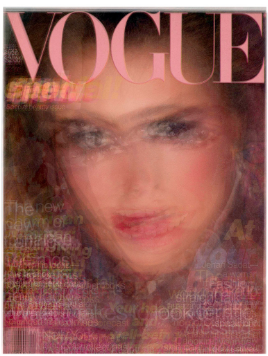http://dh.library.yale.edu/projects/vogue/
Sources
looked through Robots Reading Vogue project, which takes advantage of the vast abundance of Vogue magazines which had already been digitized through a collaboration with ProQuest and Condé Nast, the mass media company. Choosing Vogue was a strategic decision: few other magazines have consistently been published for over a century while also continuing to be familiar and of interest to many people (paraphrased from the “About” section).
Processed
One of the strengths of the project is that it is playing with the data in many different ways. They sort text and sort covers by colors. They also do something called ‘decennial sampling’ which is taking all the covers in one year, every ten years. One of the strengths of the project is the substantial, but not overwhelming size of the archive. There is a sense of completeness and constraining the sheer number of the data does not appear necessary in the experiments given. In other cases, the text that appears in all the articles is grouped together according to the words which appear the most frequently.
Presented
The project boasts a powerful N-gram search using Bookworm, an open source version of Google’s classic N-gram Viewer. They have also explored topic modeling and color analysis. Another interesting use of the data is the determination of a pixel average (through the mean of the RGB value) through a hand-crafted graphic. This composite image is the most intriguing and immediately shocking visual presentation of the work, showing an uncanny uniformity in face and position for the 1980 decade.* For their examination of color in covers over time, Robots made histogram plots of the covers over the past century and ten years in png format, labeling each by year. Then, Imagemagick reads each file and inserts a white text in each. The next step was moving the now-labeled frames into a movie with the ‘ffmpeg’ video encoder. In addition to this, the team has used ImagePlot for their map of covers arranged by color over time.This adds an interactive feature to exploring the map/graph of covers, with the ability to zoom in and out and pan to the left or right. For the word frequency element is presented by way of a series of word clouds.
*incidentally, this observation leads to a sort of thesis in the project, communicated simply and elegantly through the surprising sameness of an image. I believe that the Robots project is making an argument about a general uniformity in the magazine’s cover designs, especially for several key decades (the 70s-80s), while demonstrating that the commissioning of famous artists to design covers contributed more individualistic and unique covers in the middle of the century. Implicit in this argument is a preference for that which is original rather than copied repeatedly, though I would not classify the tone of the project’s writing to be particularly harsh. However, the fact that the project is a collaboration with Vogue makes any critique difficult, explaining why the opening sentence of the introduction feels a bit overblown: “Few magazines can boast being continuously published for over a century, familiar and interesting to almost everyone, full of iconic pictures.”
This project has an obvious application to gender studies, as listed on the website. The kinds of standards of appearance through the cover composites, the advertisers marketing to women (tobacco dying out, makeup companies staying strong), and the word clouds as vocabulary words for a certain ideal of femininity in the U.S. Again, the apparent partnership with Vogue makes me skeptical of how much can actually be said against the magazine’s influence.
